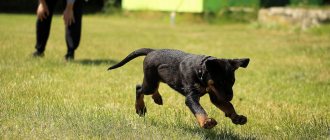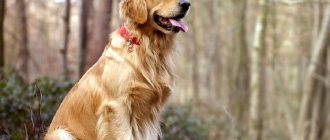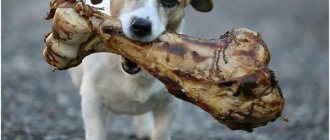Punishment is one of the most effective dog training methods. Thanks to him, it is possible to reinforce all the necessary basics of behavior and show the pet what is right and what is wrong. But before you start using this method, you need to learn the basic nuances of how to properly punish a puppy. This is a complex process in which there are many prohibited techniques. If you approach the matter illiterately, the pet will perceive punishment only as aggression and cruelty on the part of the owner. This can lead to severe nervous shock for the animal.
Punishment is one of the components of raising a dog
Features of dog psychology
All dogs are pack animals, oriented toward their owner. They socialize well and try to please people in everything. They have a simple psyche, incapable of complex thought processes. However, they are good at grasping the cause-and-effect relationship, which is the basis of any training and education. It is believed that they cannot take revenge, but they have sufficient memory to remember the attitude towards them. Excessive cruelty and aggressiveness of people leads to mental deformation, fearfulness and unstable behavior appear.
Attitudes towards punishment differ among different breeds. For example, toy terriers and Italian greyhounds only need one disapproving glance from their owner. Temperamental dogs (Asian breeds, terriers and schnauzers), as well as all hunters, require more intense exposure.
Useful tips from a dog handler
We found out why you can’t beat a dog for misdeeds and looked at the correct methods of education. Some little things, advice from professionals, will also help make training easier:
- Punishment or reward should always occur at the moment of the action itself; in dogs there is no cause-and-effect relationship. If you came home from work and scolded your dog for chewing his slippers 4 hours ago, he will not understand that they are the reason.
- During the period of interaction with the animal, be calm; excessive anger and aggression can frighten him and cause a response.
- Physical force is a last resort and cannot be used for minor offenses.
- If you think it's okay to hit your dog on the butt, never do it with your hand. Newspaper or a special whip is used to control difficult animals.
- You need to start training from the moment the puppy appears in your home. At the same time, the prohibitions must be unshakable, only then will the pet fulfill them.
- If the dog is punished, then all family members should understand this. If someone starts to feel sorry for or defend the animal, it will not learn its lesson, and the person scolding it will become “bad.”
Now you know whether it is possible to hit a dog when training. Pain is a last resort and should only be used by professionals. If you correctly apply all permissible measures of influence, the dog will obey you without experiencing fear.
When to punish
The main principle of punishing a dog is that the reaction to its actions should be immediate. It should be taken into account that the pet does not have a logical connection. If you start scolding him for his actions after some time, the animal will not be able to connect these two events. Negative reinforcement should follow immediately after the misbehavior.
For example, if you come home and find torn things and a mess, then punishing your pet will be ineffective. He will not be able to connect these two events, and as a result, the owner’s appearance will be associated with unpleasant emotions for her.
Prohibited Methods
Every person raising their dog should know several important rules that must be constantly followed:
- You can't raise your voice at a dog. Small individuals can become very frightened and become cowardly, and large ones can bite.
- Locking a dog in a room without food and water is unacceptable.
- If an animal bows its head in front of its owner and presses its tail, it means that it has realized its mistake and sincerely repents. You must immediately stop scolding the dog and let it go about its business.
- If you beat a dog with a chain or leash, then soon it will begin to be afraid of these accessories. Putting a muzzle and collar on her will no longer work.
You should always punish your pet for any offense. If this is not done, then he will feel like a leader or head of the family.
How to punish for disobedience
There are several methods of punishment in cynology. Basic forms of negative reinforcement:
- Rebuke. One of the most popular methods. Draw the dog's attention to some action. A serious tone is enough for this, but you cannot shout.
- Unexpected actions. They allow you to distract your pet in order to correct behavior and reprimand. This could be a splash of water, a clap of your hands, the sound of a whistle, or a sharp tug on the leash.
- Ignoring. This method should be used only in extreme situations. Ignore the dog until he feels guilty about his behavior. If there are several people in the family, everyone should adhere to the same tactics.
- Shaking by the scruff of the neck. This method should only be used in exceptional cases. This action imitates the behavior of the mother when raising offspring.
To demonstrate your reaction to your dog's obedience on the street, you can jerk the leash sharply. Combines with the classic “fu” command to work with your pet during outdoor walks.
After punishment, you need to limit communication, games and praise. The dog needs to demonstrate your reaction to the behavior so that it quickly learns the necessary behavior model. After the pet has demonstrated that it has understood the lesson, be sure to make peace with it.
Water treatments
Water is the most irritating factor that dogs try not to come into contact with. Thanks to water procedures, you can quickly and painlessly cool down your pet’s ardor and teach him obedience. The liquid should be cool, not hot. Don't pour a whole bucket on your dog. One large mug is enough.
How to punish a dog with water? Dog handlers recommend using a spray bottle. Started growling? Did you grab a soft toy? you need to spray the pet several times so that it stops its actions and learns that it is not necessary to do this. Training a dog is a long and painstaking job. There are many methods for raising pets.
How to punish for biting or aggression
Aggressive behavior of a pet is unacceptable - bites from dogs of even small breeds can lead to serious injuries. Due to the structure of the jaws, they easily tear skin and muscles, and the force of teeth clenching is enough to break a human bone. Increased aggressiveness of dogs does not manifest itself sharply; as a rule, this is a consequence of improper maintenance and upbringing, regular physical violence from the owner. The following types of aggression should be distinguished:
- sexual;
- defensive and defensive;
- hierarchical;
- hunting;
- gaming;
- interspecific;
- maternal.
In addition, the dog may begin to bite due to exposure to sharp external stimuli. If she bites the owner or one of the family members, the reaction in the form of punishment should be immediate. You need to immediately take the pet by the collar and give a severe reprimand. Wait for a stable state, and in order to switch attention, you can do some unexpected action.
After the first demonstration of aggression towards people, it is recommended to go to OKD courses, as well as adjust the education process so that the pet understands the hierarchy. If there have been attempts to attack other animals on the street, walks should only be carried out with a muzzle. Biting and growling should not be punished physically, which can make the situation worse. After the dog has accepted the punishment and goes to reconciliation, it is imperative to show a good attitude towards it.
The essence of the phenomenon
- Firstly, physical punishment for puppies is a completely natural process; they are first introduced to it when trained by their mother. It is important to understand that this has nothing to do with beating.
- Few trainers of the DOSAAF school (about which many now sigh nostalgically, as well as about the Brezhnev era) did without at least one strong thrashing. Again, here we are only talking about hard service breeds when training ZKS (protective guard service).
It is a fact that it is impossible to correct a puppy’s behavior that is inappropriate to the situation with words alone. Another thing is the choice of your reaction.
In the usual understanding of this term, hitting a dog is not only unethical, but also useless.
Even if you (conditionally) kick her in the butt at the moment of the “offense”, this will lead to the fact that she will understand: within the reach of the owner, I should not do this anymore. Moreover, if you come and whip her with a leash - in this case it will simply not be clear to her why she is being beaten.
There must be punishment (correction), but it must be carried out wisely.
If she shits at home
A dog can relieve itself in an apartment if it is not trained to do this outside or has diseases of the excretory system. If a puddle or heap is found in the apartment, the pet should be immediately reprimanded. To do this, it is enough to slightly increase the tone of your voice, but do not shout. It is strictly forbidden to punish with food or beat an animal. If you see that the dog wants to relieve itself, you need to distract it from this with the “fu” command. Go outside with her as soon as possible (if all vaccinations have been completed). Useful recommendations if your pet does not want to pee on the street:
- find a friend for walks together - he can become an example;
- take water with you and give the dog something to drink after it runs;
- increase walking time;
- increase physical activity, play with your pet.
On average, the process of learning to relieve yourself on the street takes 1-2 months. Depends on the characteristics of training, age and health.
Photo: pixabay.com
Rebuke
Verbal reprimand is the safest method. Many dogs respond to voice intonation and understand when their owner is reprimanding them for something wrong. But at the same time, it is important to know how to punish a puppy for disobedience, using only words. Wrong actions can provoke aggression in your pet.
During the reprimand process, you must adhere to the following algorithm of actions:
- Make a stern facial expression.
- Bend over slightly and look your pet in the eyes.
- In a calm but stern voice, say phrases such as “Ugh,” “Bad dog,” or “No.”
After verbal punishment, you need to deprive the dog of communication with the owner and long walks for a short time.
You should not shout at the puppy or wave your hands in front of him. Otherwise, the dog may bite the owner. Verbal reprimand should not last long. After all, dogs don’t understand long monologues. They are able to perceive only a very limited number of words. Therefore, you need to limit yourself to short and clear commands.
Punishment for disobedience on the street
An ill-mannered dog can show aggression towards other animals on the street, run up to people, and also pick up trash. This can be dangerous, as your pet can easily eat a poisoned product or other people's excrement, which can lead to long-term treatment. Disobedience during a walk should be punished. Basic methods:
- pulling the leash;
- command "fu";
- severe reprimand.
If your pet exhibits aggressive behavior towards others, you should always wear a leash. When you see another animal, you need to bring your dog to your leg or sit next to it. For prevention, it is recommended to enroll in general training courses. To reinforce desired behavior, it is helpful to always carry a reward treat with you. For ease of control, before starting walks on the street, it is worth teaching the dog at home the simple commands “lie down”, “sit”, “stand”.
Photo: pixabay.com
The problem is education
Often a pet becomes like this due to the fault of its owners. This is especially true for dogs of small and medium breeds, which are allowed a lot. How to raise the “leader” of your family?
- Allow your dog to sleep on your bed or pillow.
- Feed your pet first.
- Turn a blind eye to wrongdoing.
- Fulfill all your whims, including taking you out for a walk earlier than expected.
- Allow the leash to be pulled outside.
If at least one statement is true for the owner, he should do something sooner.
How to punish for damaging things
The main reasons why a dog chews and spoils things in the house is puppyhood (teeth cutting), as well as insufficient physical activity. If you find chaos when you enter the apartment, the dog should not be beaten or punished with food. You should pay attention to what is happening and give a severe reprimand.
To avoid destructive behavior in your pet, you need to achieve physical fatigue. Outdoor games, endurance activities and long walks are suitable for this. It is recommended that adult dogs and puppies leave a bone or any other dense treat, which is also useful for cleaning their teeth.
What is the reason for this behavior?
A dog can not only growl, but also demonstrate his negative attitude in other ways - bare his teeth, bark, or not complete the task given to him. An angry animal may be overly protective of its bowl, toys, or other objects that the pet considers to be its own.
In addition, the dog can show excessive dissatisfaction during hygiene procedures that it especially does not like, for example, when trimming its nails, combing its fur, or using a trimmer.
But sometimes such behavior is not a sign of aggression, it signals that the pet is confused and feels defenseless. How can you find out the cause of the growling?
Experts identify several situations that can provoke growling, anxiety and other emotions in a dog:
- The dog considers himself the master of the house . Representatives of many breeds have a tendency to dominate, which they often display when communicating with family members and other pets. Often it is the spoiled individuals who become leaders, as the owner makes the mistake of trying in every possible way to please his four-legged friend. The animal begins to be jealous of its things - food, toys, not allowing the owner to approach and take them. In addition, the dog can also encroach on objects that do not belong to him. With a growl, he declares his rights and confirms that there is only one owner in the house!
- The dog responds to cruelty with aggression . In this case, the situation is the opposite - the pet is constantly faced with cruelty directed at it, and the growling becomes a warning signal - not to approach. A dog may also growl when it is being punished or scolded for misbehavior or for no reason.
- By growling, the dog shows a sense of ownership . This behavior is typical of teenage males, who not only grow and become stronger, but also try to assert themselves. During this period, many owners are faced with the fact that an obedient and flexible dog suddenly becomes uncontrollable. This happens due to natural instincts - the animal shows its leadership qualities, and the goal of such behavior is one - to become a leader. In addition to growling, the dog can violate previously established boundaries, occupying forbidden territory. Most often, it serves as the owner’s sleeping place. At the same time, we are not talking about any fear; with all his appearance, the male shows his fearlessness and confirms his importance.
- Food aggression . In this situation, the puppy may snatch the treat, biting his hand, or growl when the owner pets him while eating. An adult dog may grin or freeze while eating food if the owner comes too close or reaches out to the bowl. This behavior can be corrected; there are several methods for this.
- Aggression of a puppy bitch . A mother always tries to protect her offspring - this is a strong innate instinct that helps bitches ensure the safety of their babies. During this period, she can show anger towards other bitches, even for no apparent reason. And keep the owner away from the puppies at home, but most often this only applies to children.
- Reaction to pain . Dogs, especially those that are overly independent and active, are often injured, receiving external or internal injuries. Sometimes the owners don’t even know about it, or the dog has no visible wounds. Naturally, when touched, the pet may growl, move away, and whine.
In almost all of these situations, except for the dominant manifestation, there is an irritant that provokes the dog. But the most difficult thing to correct is the errors of upbringing, in which the dog allows itself to behave inappropriately towards the owner.
How to punish a puppy
Is it possible to punish a dog? This is one of the first questions that arises at the beginning of training. Not only the characteristics of the dog’s subsequent behavior, but also its health depend on upbringing. The puppy's punishment should be very gentle. If he disobeys, it is enough to turn attention to yourself, and then give a stern reprimand or lightly shake him by the scruff of the neck.
A puppy can go to the toilet in an apartment for up to 4-6 months and chew things due to the active growth of teeth. In such situations, you cannot show physical and verbal aggression, deprive them of food, or drive them out into the cold. Young dogs have an active psyche, they learn quickly - from 3-4 months they can be taught the command “fu”, “near” and other necessary methods of control.
Ignoring
Stopping communication with the dog can be used as a separate method, as well as in addition to verbal reprimand. It is important that not only the owner, but also all family members stop talking to the puppy. You can also lock the dog in a separate room for a short time.
This boycott should not continue for too long. After all, loneliness has a bad effect on the psyche of puppies. Using this punishment, you cannot take away toys, a bed or food from an animal.
How not to punish a dog
When raising and training, there are a number of points that should not be allowed during punishment. This can cause changes in the psyche, resentment and loss of authority, and deterioration in socialization. Basic things you should not do:
- to cause a pain;
- hit with a hand or a sharp, heavy object;
- use collars with spikes, shock and other aggressive methods;
- take away toys and a lounger;
- intimidate;
- limit communication for a long period of time;
- use strong medications and surgery.
If you can’t establish a relationship with your dog or teach it basic commands, it is recommended to contact a professional dog trainer. Different dogs may have different behavioral reactions to punishment and reward, so it is important to take into account the temperament and character of your pet.
Second way
In each city there are specially built areas for walking and training dogs, where you can train together with other dog breeders under the guidance of a professional trainer.
This method is quite effective if there are not very many animals on the site at the same time. Otherwise, they will be distracted and interfere with each other's commands. Some dog handlers claim that dogs tend to imitate. No studies have been conducted on this claim, so it is impossible to say for sure whether this is actually true. However, dog owners claim that their pets learn science faster if they have a positive example in front of them.
Is it possible to punish a dog in front of others? Certainly! By inducing a feeling of shame in the dog, you can be sure that the offense for which he was reprimanded will not be repeated.
Briefly about the main thing
- Punishment, or negative reinforcement, is an important part of education and training.
- The reaction to aggression, damaged things and disobedience must be immediate.
- The main methods of punishment: severe reprimand, ignoring, shaking the withers.
- Even if a dog exhibits destructive behavior, it should not be beaten, starved, or deprived of companionship for a long time.
- Due to their developmental characteristics, puppies can relieve themselves in the house and chew on objects. With the right approach, this behavior goes away by 4-6 months.
Punishment is one of the most difficult aspects of raising a dog. Share your proven methods in the comments.
What not to do - the main mistakes of novice breeders
Owners make common mistakes completely unintentionally, but suffer the consequences for many years. It is also sad that the owner puts up with the dog’s disobedience, considering its defiant behavior to be a character trait.
What not to do - the main mistakes of novice breeders:
- Yield - if you give the dog a command, you need to ensure execution. Naturally, you cannot use rudeness towards a dog, but it must understand that your word is law.
- Repeat the requirements many times - the command is repeated a maximum of two times, after which the owner must ensure its execution.
- Working with a dog is not a constant thing – if you decide to raise a dog today and forget about it tomorrow, don’t expect much success. Quadrupeds learn successfully only with regular reinforcement of skills. Giving your pet unnecessary powers - thousands of owners have suffered from allowing puppies to commit seemingly cute acts. When your puppy climbs up on the couch and growls at you, he is showing dominance. When you can't touch the food bowl without risking being bitten, your dog is exhibiting food aggression. All such acts of dominance must be stopped during puppyhood.
- Do not clearly formulate the requirements during training - the dog should only hear the command and tone of voice; accompanying phrases like: “who did I tell”, “how many times can I repeat” are absolutely meaningless and only confuse the dog.
If you got your first dog and feel like you can’t cope, it’s better to seek help without delay.











